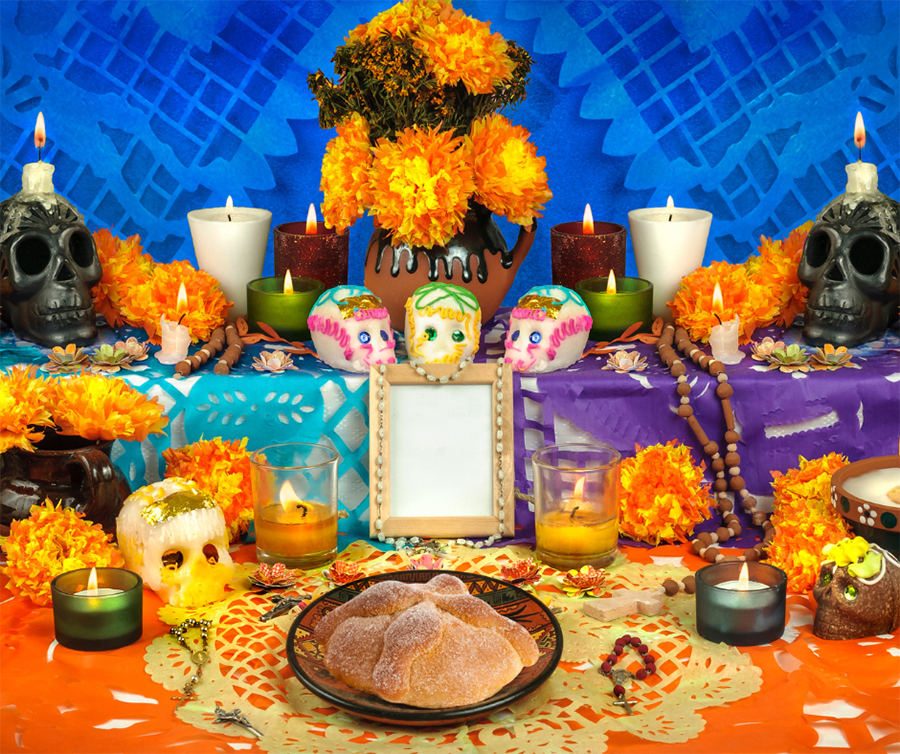A Celebration of Life And Death: Day Of The Dead in Playa del Carmen

What Is Day Of The Dead
Celebrated on November 1 and 2nd, Día de los Muertos (Day of the Dead), is a deep-rooted cultural holiday in Mexico. In essence, it’s a time when families and friends gather to commemorate the lives of those who’ve passed and honor their journey in the afterlife.

It is said that on the 1st of November, the spirits of the children who have passed come to reunite with their families. While on the 2nd of November, the adults make their return to their beloved kin. Those still living believe that if the spirits are kept happy, they will provide the family with protection, wisdom, and good fortune. For this reason, some households spend more than a month’s income on the celebration.
Customs and Traditions
Perhaps the most relevant of the traditions of Day of the Dead is the creation of altars, or ofrendas. These shrines are erected in homes and cemeteries and decorated with customary items such as the marigold. Due to their pungent scent and deep orange color, the flowers are believed to attract the souls of the deceased to the offerings. Besides flowers, typical decor may include candles, food, tequila, and favorite toys and trinkets of the departed. Loved ones believe that the offerings compel spirits to return for a temporary visit to commune with them.

Another important tradition is the calavera, or sugar skull. Colorful skulls, often made of sugar or chocolate, bear intricate designs created with bright colors. They sit adorning altars and are also gifted to friends and family members, usually children.
Attire can consist of black dresses, trousers, top hats or elegant sombreros, and bouquets of dead roses. Alternatively, some choose white suits or white embroidered tunics, called huipils, with flower crowns. The key factor is the painted skull face. This represents The Day of The Dead’s most iconic figure, La Calavera Catrina, who signifies the transition to the afterlife. Through this tradition, death denotes a festive tribute to the circle of life rather than an ending to be feared.
On the eve of November 2nd, families gather at cemeteries in candlelight processions. The gravesites are cleaned and transformed into unique altars. Food and drink are placed on the tombstones and mausoleums to be shared amongst the group, both the dead and alive. Along with refreshments, people bring instruments, sing songs, and share cherished memories of their dearly departed into the night.
Celebrating Dia De Los Muertos in Playa del Carmen, Mexico
In Playa del Carmen, the famed 5th Avenue becomes flooded with festival goers bearing elaborately painted calavera faces. Markets display typical Day of the Dead items including candles and marigolds bunches. As well, papel picado or “punched” tissue paper in a variety of vibrant colors, is hung to symbolize the fragility of life.

However, the main attraction in this popular Riviera Maya beach town is the annual Festival of Life and Death held at Xcaret Park. The remarkable celebrations take place over four days beginning on October 30. Participants can enjoy a packed program showcasing live music, theater, and dance performances. In addition, there are equestrian shows, guided tours, altar and art exhibitions, festive parades, and workshops.
Plus, there are a plethora of outdoor food stands offering traditional cuisine. For example, you’ll find esquites (a tangy, creamed corn), velvety mole chocolate sauce, cochinita pibil (smoked pork), Pan de Muerto, and sweet rice pudding. There are a slew of events and tastes for every age!

Overall, Day of the Dead is a beautiful and meaningful holiday. This historic tradition honors the memory of those who have passed, while celebrating the beautiful richness of life itself. If you’ve never encountered this special occasion in Mexico, we encourage you to reach out to our Bric hospitality experts. For one, you can book an exceptional stay through them. Moreover, they’re happy to share the best tips for participating in Day of Day of the Dead activities in Playa del Carmen.

